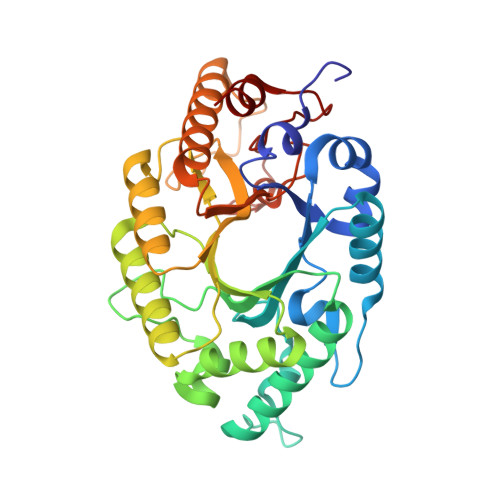Structure-specificity relationships of an intracellular xylanase from Geobacillus stearothermophilus
Solomon, V., Teplitsky, A., Shulami, S., Zolotnitsky, G., Shoham, Y., Shoham, G.(2007) Acta Crystallogr D Biol Crystallogr 63: 845-859
- PubMed: 17642511
- DOI: https://doi.org/10.1107/S0907444907024845
- Primary Citation of Related Structures:
2Q8X - PubMed Abstract:
Geobacillus stearothermophilus T-6 is a thermophilic Gram-positive bacterium that produces two selective family 10 xylanases which both take part in the complete degradation and utilization of the xylan polymer. The two xylanases exhibit significantly different substrate specificities. While the extracellular xylanase (XT6; MW 43.8 kDa) hydrolyzes the long and branched native xylan polymer, the intracellular xylanase (IXT6; MW 38.6 kDa) preferentially hydrolyzes only short xylo-oligosaccharides. In this study, the detailed three-dimensional structure of IXT6 is reported, as determined by X-ray crystallography. It was initially solved by molecular replacement and then refined at 1.45 A resolution to a final R factor of 15.0% and an R(free) of 19.0%. As expected, the structure forms the classical (alpha/beta)(8) fold, in which the two catalytic residues (Glu134 and Glu241) are located on the inner surface of the central cavity. The structure of IXT6 was compared with the highly homologous extracellular xylanase XT6, revealing a number of structural differences between the active sites of the two enzymes. In particular, structural differences derived from the unique subdomain in the carboxy-terminal region of XT6, which is completely absent in IXT6. These structural modifications may account for the significant differences in the substrate specificities of these otherwise very similar enzymes.
- Department of Inorganic Chemistry and the Laboratory for Structural Chemistry and Biology, The Hebrew University of Jerusalem, Jerusalem 91904, Israel.
Organizational Affiliation:


















